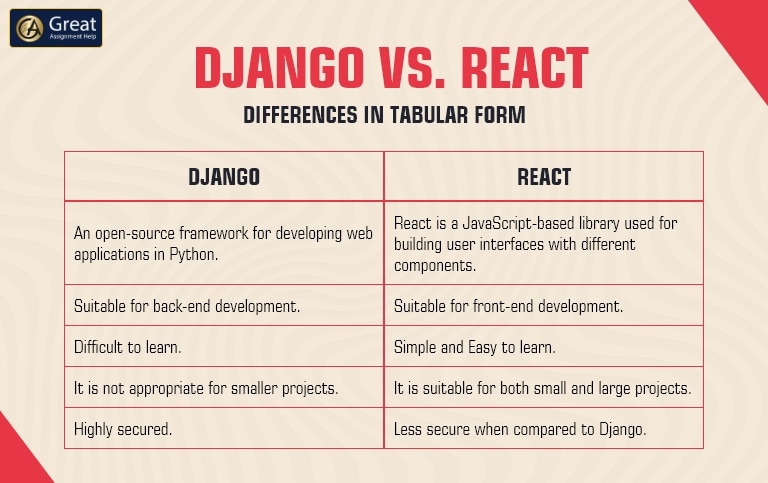Django vs. React: Which is the right tool? Django is a backend framework that is used for building server-side applications. React is a frontend library used for creating user interfaces. Both frameworks serve different purposes, but can work together seamlessly. Especially by understanding their strengths, you can decide which one to use for your project, or how to use both.
In recent times, both Django and React have been widely used for web development. However, many people get confused about what framework to use and which one is better. So, to give them clarification for all the queries they have, here, in this blog post, we have presented a comparative analysis of Django vs. React. Continue reading to learn more about the advantages, disadvantages, and features of Django and React.
Before we see the comparison of Django and React, let us have a look at what these frameworks mean.
What is Django?
Django is a high-level Python web framework that is predominantly used for the rapid development of secure websites that are convenient for maintenance. It is a free, open-source framework that was developed and managed by the Django Software Foundation. The framework sticks to the model-view-template (MVT) architectural pattern. With Django, the back end can be developed efficiently by directly accessing the existing sources. Django has an active community and also has great documentation. Moreover, it also has some options for paid and free support.
What is React?
React is a library that is used for building user interfaces. To put it simply, React is a UI development library based on JavaScript. Since React is a library and not a language, several developers prefer it for front-end web development, like user interfaces. With React, the user interfaces of each web page can be created easily with different pieces called components.
Django vs. React- Features
Here, let us have a look at the prominent features of Django and React.
Features of Django
- It is one of the best open-source technologies that provides an excellent documentation facility.
- Highly scalable
- More Versatile
- Highly secure
- Supports rapid development
Features of React
- Virtual DOM is one of the best features of React that allows users to speed up the application development process and offers flexibility.
- React provides a one-way data-binding facility. In the entire application development process, data will flow in a single direction and provide better control over applications.
- In React, a web page is also divided into various components, like ReactJS. But React defines each component as a view.
- Another special feature is that, in React, conditional statements can be used inside the JSX.
Also Read- The Differences Between Flask and Django
Django vs. React- Advantages
Listed below are the advantages of using Django and React for the web development process.
Advantages of Django
- The Django framework enables quick application development. Hence, the developers can use it to create Minimum Viable Products (MVPs) rapidly and take advantage of their competitors.
- Since Django relies on Python, a dynamic and versatile language, it is highly flexible. Moreover, the framework can be configured quickly, irrespective of its specifications.
- The Django framework contains several libraries, packages, and add-on modules necessary for developing the back end of a web application. It mainly concentrates on web development-related tasks such as content administration, user authentication, site maps, RSS feeds, etc.
- Django was developed by the world’s top-rated web developers, and hence, there are only a few security issues. Most importantly, Django prevents common threats and attacks such as SQL injections and cross-site request forgeries.
- It is highly versatile and scalable. Particularly, Django can efficiently handle more traffic on the busiest website. Also, it has proven its versatility in several industries and applications such as scientific computing, enterprise management, content management, and intelligent automation.
- Django helps to build a project that runs on different operating systems, such as Mac, Linux, or Windows.
- The Django community provides thousands of tutorials and relevant, credible sources.
- The website need not be developed from scratch because Django admin offers simple off-the-shelf views.
- Django APIs can be set easily using the Django REST Framework.
- The Django web framework works with the majority of the databases, and it also simultaneously uses multiple databases for a particular project.
Advantages of React
- React is easy to learn. Therefore, with React, even different projects can be completed in a shorter duration.
- It supports the creation of custom components. In particular, unique components according to your needs can be created with React.JSX. Moreover, it also minimizes sub-component rendering using HTML code.
- With React’s developer tools, it is easy to inspect and debug the state.
- React also reuses components so that developers can reuse the same digital objects. This also increases the productivity of developers.
- ReactJS is also SEO-friendly. Hence, it is helpful for businesses to earn a first-page ranking in Google searches.
- With React, super-fast rendering can be done. Especially, it helps users drastically reduce the loading time of a page.
- Dynamic applications can be developed using React.
- The features of ReactJS help to build both web and mobile-based applications.
- React can be used for creating isomorphic applications, where the same style is used for writing both the client and server-side components.
Django vs. React- Disadvantages
Every coin has two sides. Like advantages, Django and React also have certain disadvantages. Here, let us have a look at the cons of both Django and React.
Disadvantages of Django
- Due to a lack of conventions, a lot of programmers hate using Django. Moreover, in it, everything is explicitly mentioned in distinction to frameworks like Ruby on Rails.
- Django has numerous features, and hence it is difficult for the majority of developers to learn and understand. This makes it troublesome for some developers to switch to another language.
- Django is not suitable for the development of smaller products or projects with fewer requirements because its code consumes more server processing time. Also, it takes a toll on web pages that run on a smaller bandwidth.
- Like modern frameworks, Django can’t handle multiple requests simultaneously. Hence, it is difficult to optimize the processes efficiently.
Disadvantages of React
- Poor documentation facility.
- Using React, a complete web application cannot be developed.
- React supports rapid application development, and hence, a lot of pressure can be created on developers.
- When compared to other popular frameworks like Vue, React takes a longer time for web development.
Django vs. React: A Comparison Table

For your better understanding, here we have presented a table mentioning the differences between Django and React. Just take a look to know about them.
| Django | React |
| An open-source framework for developing web applications in Python. | React is a JavaScript-based library used for building user interfaces with different components. |
| Suitable for back-end development. | Suitable for front-end development. |
| Difficult to learn. | Simple and Easy to learn. |
| It is not appropriate for smaller projects. | It is suitable for both small and large projects. |
| Highly secured. | Less secure when compared to Django. |
Alternatives to Django and React
Till now, we have seen different things about Django and React. For web development, besides Django and React, some developers also use the following alternatives in place of them.
- JS
- Laravel
- Flask
- Rails
- PHP
Integration of Django and React
Django and React can be used together to create a full-stack web application. Here is a high-level overview of how they can be integrated:
- Django as the Backend: You can use Django to create a RESTful API that handles data storage, authentication, and server-side logic.
- React as the Frontend: By using React, you can create a responsive, interactive UI that consumes the Django API.
By combining Django and React, you can leverage the strengths of both frameworks to build a robust, scalable, and maintainable web application.
Which is Better- Django or React?
This question is tough to answer. Even many developers find it difficult to identify a good framework out of these two. Both Django and React have their pros and cons, and there is no one best framework for a particular project.
In general, both Django and React are more powerful in various ways. But when compared to React, Django is more complex to learn. In designing aspects, Django suits well for non-designer developers, whereas React is appropriate for designers. Overall, the project specifications play a vital role in choosing the best framework.
Note that these frameworks will be updated frequently. For instance, React 16 uses a new JavaScript feature, and Django 3.0 was just announced.
What Should You Learn First- Django or React Native?
If you have raised this question, then for building a web application, possibly, you would have restricted your search to two of the best technological frameworks. Both Django and React are highly popular with a large and growing community. So, instead of choosing between these two, better to learn both of them. If you learn two programming languages and two frameworks, then you will have the versatility to accept different job types.
For front-end development, you can use ReactJS, and for back-end development, you can prefer using Django. However, with the Django REST framework, the front end (ReactJS) and back end (Django) can be connected. But, before you decide, make sure that you have strong knowledge of Python or JavaScript.
Conclusion
Till now, we have seen Django vs. React in detail. So, we believe that you have gained a better understanding of the different features, pros, and cons of using Django and React for web development assignments. Django is a comprehensive framework that is available for rapid web development. But, on the other hand, React is a JavaScript framework for creating a single-page application. React is a good choice for a simple to-do list application, but Django should be able to handle a more robust user profile application with ease.
If you still doubt which framework to use, then take our expert programming assignment help online. Our team consists of programming specialists in different coding languages. So, it is easy for us to help you make the right choice and handle real-time projects using frameworks such as Django and React.



